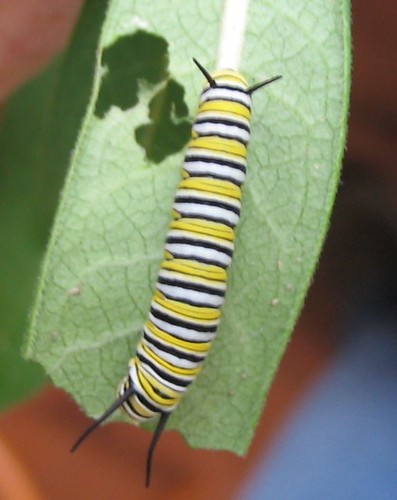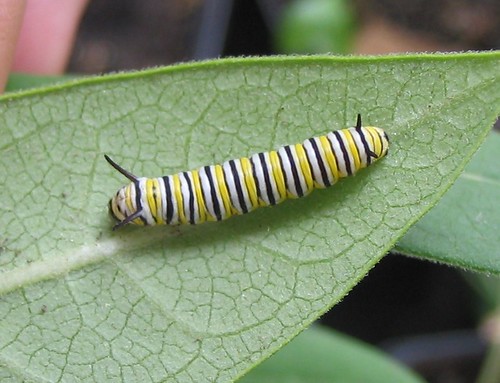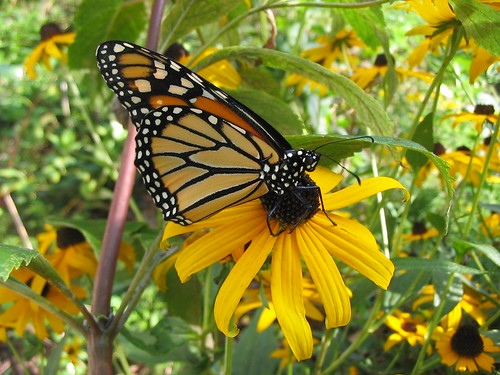 The life cycle of a monarch butterfly is pretty amazing. And you can not only watch, but be a part of helping to make it happen.
The life cycle of a monarch butterfly is pretty amazing. And you can not only watch, but be a part of helping to make it happen.Over the summer months in our area, there are multiple generations of monarchs. Adults mate and then lay their eggs on the leaves of milkweed plants. Caterpillars hatch from the eggs and proceed to devour as much milkweed as possible for the next two weeks or so of their lives, shedding their skin several times as they grow.
 When they're ready, the monarch caterpillars will look for a good place to pupate, attach themselves upside down with a strong mass of silk threads, and shed their skins one more time. Their next skin hardens into a beautiful chrysalis, like jade decorated with sparkling gold.
When they're ready, the monarch caterpillars will look for a good place to pupate, attach themselves upside down with a strong mass of silk threads, and shed their skins one more time. Their next skin hardens into a beautiful chrysalis, like jade decorated with sparkling gold.Inside the chrysalis, the monarch pupa takes another two weeks or so to transform into a butterfly. The night before it is ready to hatch, you can see the butterfly inside: the chrysalis looks as if it has turned from green to black.
Early in the morning, the butterfly will split open its chrysalis, crawl out, and hang from the empty shell. It must pump fluid into its wings before they will stretch out to their full size. Here's a video we made a few years ago of the whole process as it took place in our kitchen:
 Want to try your hand at it? To find caterpillars to raise, look for milkweed. Try looking along roadsides, the edges of playgrounds, or other "waste" places. Remember the caterpillars can be very small when they first hatch. They're probably trying to hide from you and the birds -- look on the undersides of leaves.
Want to try your hand at it? To find caterpillars to raise, look for milkweed. Try looking along roadsides, the edges of playgrounds, or other "waste" places. Remember the caterpillars can be very small when they first hatch. They're probably trying to hide from you and the birds -- look on the undersides of leaves.Before you bring any caterpillars home, make sure your schedule will allow you to replenish their food supply (milkweed leaves) every day or two. The leaves need to be kept fresh -- the best way seems to be picking whole stems and keeping them in water like cut flowers. We usually do this in a jar with holes poked in the lid, so the caterpillars can't fall into the water (we've drowned a few).
 Your caterpillars will be so intent on eating that you don't have to do anything to cage them until the end of their larvaehood. But when they're ready to pupate, they will wander. We put ours in a small aquarium, and they attach themselves to the sides or the screen on top. You can also get a container made especially for raising butterflies.
Your caterpillars will be so intent on eating that you don't have to do anything to cage them until the end of their larvaehood. But when they're ready to pupate, they will wander. We put ours in a small aquarium, and they attach themselves to the sides or the screen on top. You can also get a container made especially for raising butterflies.Report back in the comments and let us know how it goes -- or share your own tips for raising butterflies!


